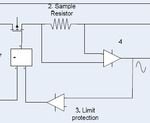zhengchao201105
Member level 2
I am making a audio current limit protection circuit.and I got a block which share me some ideas.
you can find the block.

they recommend to use LT6100 for current sensor,I use LTspice to simulate the result and find it is useful to DC but not good for audio signal.
the output is also a sine wave and the amplitude is proportional to the LT6100 supply voltage but not the input sine wave amplitude.
so should I need some special chips to measure the sine current?
the audio signal will connect to a 8ohm speaker ,so I think the current RMS value is big enough in some case.


if current value is difficult to detect,so should I choose some voltage limit protection circuit,if I define the current limit value is 4A,so the voltage limit value is 4*8=32v,and the peak to peak value is 32*1.414v=45v?
the sine wave current limit protection is giving me a headache,so hope you can share me your idea?thank you!
you can find the block.

they recommend to use LT6100 for current sensor,I use LTspice to simulate the result and find it is useful to DC but not good for audio signal.
the output is also a sine wave and the amplitude is proportional to the LT6100 supply voltage but not the input sine wave amplitude.
so should I need some special chips to measure the sine current?
the audio signal will connect to a 8ohm speaker ,so I think the current RMS value is big enough in some case.


if current value is difficult to detect,so should I choose some voltage limit protection circuit,if I define the current limit value is 4A,so the voltage limit value is 4*8=32v,and the peak to peak value is 32*1.414v=45v?
the sine wave current limit protection is giving me a headache,so hope you can share me your idea?thank you!
Last edited:
